The Kunstmuseum Magdeburg has a highly respectable collection of contemporary art and among the authors who should be mentioned from an Italian point of view, we cannot fail to mention Enrico Castellani and Jannis Kounellis. Furthermore, a characteristic feature of this museum is the sculpture park which surrounds the museum building and whose arrangement was started at the end of the 1980s: the open spaces, which extend from Breite Weg to Elba, were conceived with the aim of offering both the opportunity for a pleasant walk among trees and meadows and allowing a perception of the artworks without having to face a more demanding journey within the walls of an enclosed space.
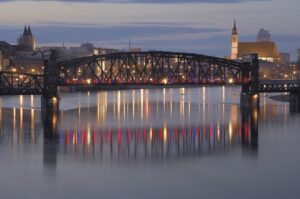
Maurizio Nannucci, Von soweit her bis hierhin / Von hier aus noch viel weiter, 2007/08, neon. © Kunstmuseum Magdeburg. Photo: Hans-Wulf Kunze, courtesy Kunstmuseum Magdeburg
The approximately fifty sculptures scattered throughout the park were made from the mid-20th century to the present day. In addition to the historical inventory of representative GDR and pre-1989 bronze works (e.g. by Gustav Seitz, Fritz Cremer, Waldemar Grzimek, Jenny Mucchi-Wiegmann, Wieland Förster, Werner Stötzer and many others), the focus is on later concentrated on works of international contemporary art, for example by Ian Hamilton Finlay, Alicia Paz, Nathan Coley, Gloria Friedmann, Auke de Vries, Schang Hutter, Heinz Breloh or Susan Turcot. According to the pertinent spirit of the collaboration between curator and artist (which was taught to us by Harald Szeemann), these works are not set in an abstract way, but have been designed to establish a perfect union with the place in which they have been set up and are therefore the the result of a dialogic project built over time and with space.
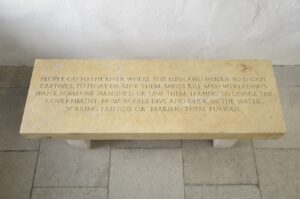
Jenny Holzer, Two Benches, 1999, sandstone. © Kunstmuseum Magdeburg. Photo: Hans-Wulf Kunze, courtesy Kunstmuseum Magdeburg
This can be seen, for example, in the texts by Jenny Holzer engraved on two 1999 sandstone benches located in the lower cloister, or in the sculpture “Chrysalis”, 1996/2007, by Ian Hamilton Finlay with its poetic reference to the decrease in traffic maritime on the Elbe. In the work “For other People and other Works” by Nathan Coley, two rectangles, joined together to form a surface, define a geometric construction that reflects the character of the park as a whole: as a place to welcome art, but also as a place to rest, stop, meditate. The monumental neon work by Maurizio Nannucci, with the double inscription “Von soweit her bis hierhin / Von hier aus noch viel weiter”, 2007/2008, with a length of 2 x 90 meters, located on a bridge over the Elbe, just beyond the sculpture park, stands as a symbol of times and changes and is highly effective above all with a nocturnal perception that reflects the lights of the text in the flowing water and concludes the path of the walk in the park.
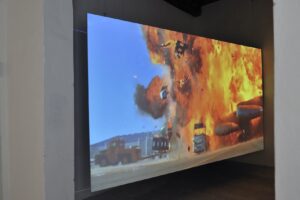
Hito Steyerl, After the Crash, 2009 © Kunstmuseum Magdeburg, photo: Hans-Wulf Kunze
But the museum has a vital conception of its collection and of the times it is called to bear witness to. And since the end of the last century, video has become an artistic medium with rights equal to those of more traditional media, the Kunstmuseum’s collection of media (video/film) has been launched since 2005, with examples ranging from pioneers from the Sixties up to the most recent testimonies, with the works of John Smith, Dagmar Varady, Sigalit Landau, Sean Snyder, Andrea Fraser, Beat Streuli, Annika Kahrs, Nan Hoover and Hito Steyerl.
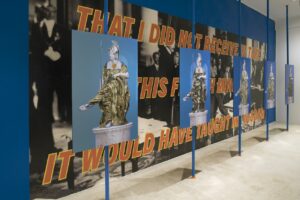
Cemile Sahin, It Would Have Taught Me Wisdom, 2021, exhibtion: Looking for Humanity. © Kunstmuseum Magdeburg, photo: Hans-Wulf Kunze, courtesy Kunstmuseum Magdeburg
In the wake of this awareness, the Kunstmuseum Magdeburg is hosting the exhibition “Looking for Humanity” until 24 September 2023, where international positions in the fields of photography, video art and installations that are currently involved in the debate on power and on its effects and who take a position from the point of view of a humanity that responsibly understands that it has to live in a fragile and fragmented world in many ecosystems. Consequently, the constant renegotiation between art and life, between political activities and their results, is presented as a topic to be linked to the artistic experiences of our time and asking us unavoidable questions: how do we want to live in the future? How and where do we go in search of humanity? The power in the hands of the artists lies in blurring the boundaries between the certain and the uncertain, in redistributing the relationships between space and time, between reality and fiction. The artists pose doubts, explore physical, emotional and aesthetic boundaries and therefore also target the practices and logics of political action itself. It is about the fragility of representative bodies and the limits of parliamentary democracy, war and peace, freedom and the desire for self-determination of every human being. The focus is on personal commitment, which consequently turns against a policy that claims to propagate segregation and exclusion.
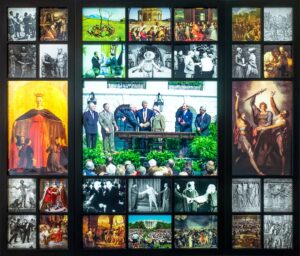
Jonas Englert, Declaration of Principles, 2022, installation, Heussenstamm-Frankfurt. Photo by Elias Michael
The works in the “Looking for Humanity” exhibition can therefore be read as seismographs of today’s political activity and invite people to confront the questions of the future that concern us as human beings. Here are the artists who have been involved in the project: Yael Bartana, Pauline Boudry/Renate Lorenz, Sergey Bratkov, Chto Delat, Johanna Diehl, Jonas Englert, Jochen Gerz, Manaf Halbouni, Robert Kunec, Anna Malagrida, Cemile Sahin, Nasan Tur, Silke Wagner, Tobias Zielony. The exhibition is accompanied by a series of lectures, Let’s Talk, which takes place in collaboration with the State Center for Civic Education of Saxony-Anhalt.
Fabio Fabris
Info:
AA.VV., Looking for Humanity
14/05 2023 – 24/09/2023
KMd (Kunstmuseum Magdeburg)
Regierungstr. 4-6
39104 Magdeburg
kontakt@kunstmuseum-magdeburg.de
kunstmuseummagdeburg.de

is a contemporary art magazine since 1980



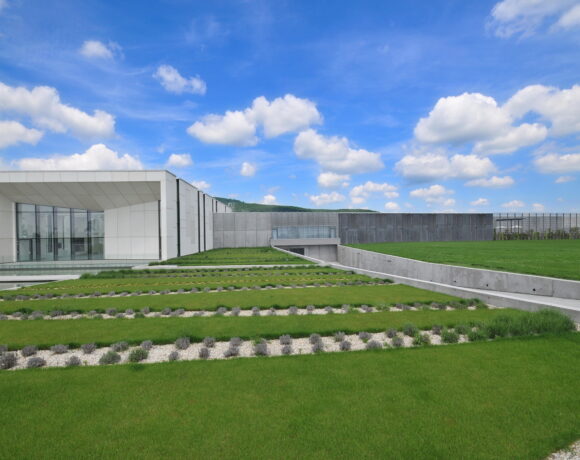


NO COMMENT